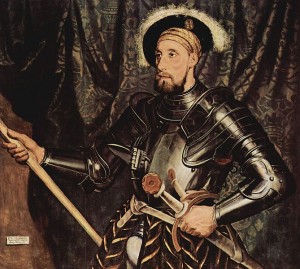
On St George’s Day (23rd April) 1536 the annual chapter meeting of the Order of the Garter took place at Greenwich. The following passage is taken from Letters and Papers, Foreign and Domestic, Henry VIII, Volume 10:-
“On St. George’s Day, 23 April 28 Hen. VIII., a chapter of the Order of the Garter was held at Greenwich, at which were present the King, the dukes of Richmond and Norfolk, the earls of Northumberland, Westmoreland, Wiltshire, Sussex, Rutland, and Oxford, lord Sandys, and Sir Wm. Fitzwilliam. It was determined to hold the feast on May 21, the earl of Northumberland taking the Sovereign’s place, assisted by the earls of Rutland, Westmoreland, and Oxford, and Sir Wm. Fitzwilliam. Votes were taken for the election of a knight; and the next day, after mass for the dead, the King declared Sir Nic. Carew elected. He was installed when the feast was kept, on May 21. On this occasion the earl of Northumberland was seized with vertigo and weakness, so that it was feared he would not be able to take his part as deputy, but he recovered. The next day the hatchments of the deceased were offered up.” 1
The appointment of Sir Nicholas Carew was significant because Anne Boleyn had put forward her brother, George Boleyn, Lord Rochford, for the post. Was this a warning sign of the trouble to come? Maybe. Sir Nicholas Carew was an enemy of the Boleyn faction and “the man who had been mentoring Jane Seymour.” 2. The Imperial ambassador, Eustace Chapuys, wrote that “the Concubine has not had sufficient influence to get it for her brother” 3, seeing it as a sign that Anne Boleyn had lost her influence over the King. Weir does point out that the Duke of Richmond, Henry VIII’s illegitimate son, had voted for Anne’s brother, and that perhaps Chapuys was reading far too much into Carew’s appointment and that it was more to do with Henry VIII promising Francis I that he would consider Carew when a vacancy for Garter Knight arose. However, whatever the reason for it, appointing Carew instead of Rochford was, as Weir puts it, “a public snub to Anne.” 4
With the benefit of hindsight we can see this event as a warning sign of the events to come, as a sign that Anne had lost her influence with the King and that the Boleyn faction was losing favour, but perhaps we, like Chapuys, are reading too much into it.
By the way, Sir Nicholas Carew came to a sticky end. He was implicated in the 1538 Exeter Conspiracy, a plot to depose Henry VIII and to replace him with Henry Courtenay, 1st Marquess of Exeter and cousin of the King through his mother Catherine of York. Courtenay was executed on the 9th January 1539 and Carew was executed on the 3rd March 1539.
Notes and Sources
1 – L&P, x. 715
2 – The Lady in the Tower: The Fall of Anne Boleyn, Alison Weir, p88
3 – L&P, x. 752
4 – The Lady in the Tower: The Fall of Anne Boleyn, Alison Weir, p89